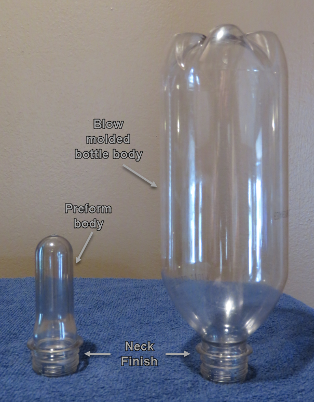Plastic bottles used for beverages are typically made from a polymer called PET (Polyethylene terephthalate). The average weight of a 500 ml PET bottle used to package bottled water has been reduced by approximately 50% since the year 2000. Lighter weight bottles reduce cost and help to make PET a more sustainable packaging option. Bottle designs have been light-weighted to such an extent that today’s utility water bottles are approaching a “bag with a bottle cap.”
While it is less noticeable for water bottle applications, carbonated soft drink applications have also become much lighter since the year 2000. Carbonated soft drinks are typically pressurized to the 4 – 5 atmosphere/bar pressure range. This internal pressure subjects the walls of PET bottles to a significant degree of tensile stress.
With less PET available to make up the walls of today’s bottles, distribution of the material throughout the bottle walls is critical. Regions of the bottle that do not have sufficient wall thickness will be weak points that can lead to bottle damage or even failure as the filled package makes its way from the filling plant to the consumer. With less margin for error, correct bottle design and manufacturing processes to consistently meet design intent have never been more critical than they are today.
Large scale production of PET bottles for beverages are produced by a 2-step process. In the first stage, PET pellets are injection molded into preforms, which consist of thick bodies that resemble laboratory test tubes, with threaded neck finishes onto which closures (bottle caps) will be applied after product filling. Preforms can be stored in bulk boxes or totes containing several thousand pieces and later blown into bottles at the same site or shipped to a filling plant to be blown into bottles immediately before filling.
In the second step of the bottle production process, the preform bodies are heated, stretched, and blown into the final bottle shape. This 2-step bottle production process is known as reheat stretch blow molding, as the injection molded PET preform bodies are heated again (“reheated”) and stretched they are blown into bottles. Figure 1 shows example images of the two stages.

Figure 1. PET preform and resulting bottle after reheat stretch blow molding.
While distributing the optimal amount of material into all regions of the bottle has always been important, today’s light-weight designs make accurate and consistent material distribution even more critical. In addition, today’s lighter preforms are often blown into high strength carbonated soft drink bottles at filling plants. While blowing at the filling plant for relatively low strength water bottles has been standard for many years, blowing carbonated soft drink bottles, which package contents at high pressure, has become more prevalent over the past decade or so.
Blowing at the filling site further improves sustainability as many more preforms than empty bottles can be delivered to the filling plant by a single truck. Blowing of bottles at the filling site places a heavier premium on confirming that the distribution of material is within design tolerances. The operators who blow and handle the bottles at the filling plant do not tend to have the expertise in plastics and bottles that is possessed by operators in the converting plants where preforms are blown into bottles at the same site. This reduced level of expertise at the blowing site increases the risk of problems if proper material distribution is not confirmed at startup and monitored throughout production.
A coarse determination of material distribution PET bottles can be made by a Section Weight analysis. In this method, bottles are cut into 3-5 sections, which are weighed and compared to design parameters. This method provides a rough idea of whether the material distribution is correct. Alternatively, high resolution mapping of wall thickness provides much more information, including details from critical regions such as the feet of petaloid bottles.
Torus Group offers automated mapping of wall thickness via our B300 Bottle Wall Thickness Gauge or B302 TBT (Thread – Body – Thickness) Gauge, which includes additional technology allowing integration of critical threaded neck finish and body dimensions to be taken simultaneously. As shown in Figure 2, the sample bottle is held upside down by the neck finish and a sender/receiver pen maps wall thickness at programmed locations providing highly reliable measurements data which can then be analyzed by quality or process personnel.

Figure 2. Torus automated wall thickness mapping of a plastic bottle.
The Torus approach offers the following advantages:
Detailed mapping of the material distribution in a bottle confirms that the minimized amount of PET available from today’s light weight preforms is making it to all regions of the bottle in adequate amounts. The use of this detailed information can allow packages to thrive at the lowest possible weights with minimal risk of failure due to inadequate distribution of the material.
Demonstration videos of the bottle inspection equipment referenced above can be viewed at:
B300 You Tube link https://www.youtube.com/watch?v=i_aazrVRYh0
B302 You Tube link https://www.youtube.com/watch?v=5BK3uUVUEWM
Please contact us with any questions. We will be happy to discuss this topic and Torus solutions in more detail.